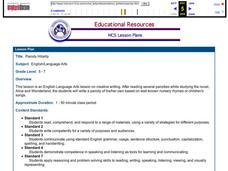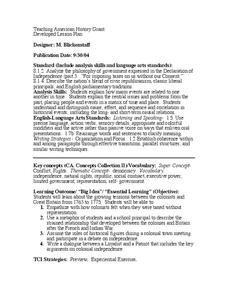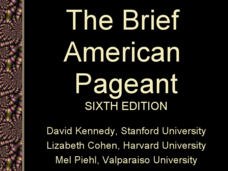Stanford University
Korean War
Learners study the cause of the Korean War. In this World history lesson, Students read excerpts from two different textbooks, one from South Korea, and one from North Korea. They discuss how the cause of the war differs depending on the...
Curated OER
Railroad Idioms Art Lesson Plan
Sixth graders research railroad idioms. In this idiom lesson, 6th graders read through a glossary of different railroad idioms and their meanings. They illustrate a chosen idiom.
Curated OER
Simile Stories
Fourth graders view song lyrics and identify similes in the song text. In this similes lesson, 4th graders define and identify similes on a worksheet. Students write their own similes using various adjectives.
Curated OER
Charles Lindbergh: Against The Wind
Learners study the life of Charles Lindbergh, one of the 20th century's most famous men. This aviator became an American hero when he successfully crossed the Atlantic in his plane, The Spirit of St. Louis.
Curated OER
Parody Hilarity
Upper grade and middle school writers study the art of parody. In this language arts lesson plan, learners study the work of Lewis Carroll, read and discuss parodies from the book, Alice in Wonderland, and construct their own parody...
San Bernardino Co. Supt. of Schools
Was Julius Caesar a Good Leader for Rome?
Learners consider the various perspectives that different groups in Roman society may have had for Julius Caesar, such as Roman soldiers, senators, the working class, and slaves. The primary activity involves a reading of Caesar's...
Curated OER
Inside Catlin's Head
Students will develop a variety of skills that include spatial, body kinesthetic, and communication skills. They create journal entries about the artist George Caitlin and a script for a theatrical skit.
Curated OER
Cultural Vantage Points
Eighth graders investigate the history of Beaverhead County and Big Hole Valley. They focus on the Native American people groups of the immediate area. Students read about the journey of Lewis and Clark to create historical context. Then...
Curated OER
Foreign and Defense Policy: An Overview
Twelfth graders explain why the United States have a policy for its relationship with the rest of the world. They examine their clothing and shoes or other personal items to determine which were manufactured in the US and which in...
Curriculum Corner
“I Can” Common Core! 3rd Grade Reading
Third grade readers are given clear learning goals with this Common Core checklist. By turning each reading standard into an I can statement, children can focus on mastering the required grade level skills.
Curated OER
Salt of the Earth: A Caddo Industry in Arkansas
Middle schoolers explore the history of the Caddo Salt Industry found in Arkansas. Along with learning about how salt deposits formed in Arkansas, learners study the process of salt production and how valuable salt is as a natural...
Curated OER
The Constitution.
Second graders study the Constitution. They examine the meaning and fundamentals of the Preamble of The Constitution of USA. They assess the importance of having a Supreme Law that states the rights and obligations of the citizens. They...
Curated OER
The Declaration of Independence
Students empathize with the colonists. In this lesson on the Declaration of Independence, students collaborate to problem solve a school dilemma that enables them to understand the issues and difficulties that occurred in the creation of...
Curated OER
Mills of New Hampshire
Students locate mill sites on a New Hampshire map. They describe who worked in the mills and their working conditions. They examine the environmental impact of the mills and work together to find out more information about mills.
Curated OER
The Brief American Pageant: The Resurgence of Conservatism
Take a short trip back in time with this presentation, which details the political and electoral contexts of 1980's and 1990's America. Covering the Gulf War as well as domestic economics, these slides feature easy-to-read charts and...
Curated OER
Lines Of Connection
We need the help of your history detectives! After giving them a set of questions to answer, reading groups must create their own timeline of the events. Then, as a class, have each group present their timelines. What is different? Why...
Curated OER
The Brief American Pageant: The Cold War Begins
With the beginning of the Cold War came numerous social and political changes around the world - many of which are featured in this series of maps and graphs. This short but informative slideshow will help to bridge the gap between a...
Curated OER
The Brief American Pageant: American in World War II
From the home front to the middle of Europe, America's presence in World War II was forever transitioning with the strain of war. The variety of maps and charts offered in this presentation helps to contextualize the 1940's. The amount...
Curated OER
The Brief American Pageant: The Eisenhower Era
Starting with the election results of Eisenhower over Stevenson in 1952, this presentation features additional maps about the elections of 1956 and 1960, with electoral votes by state. Additional slides detail the Far East (Vietnam,...
Curated OER
Turn of the Century
Students explore the transformation of America's economy in response to the Industrial Revolution in terms of patterns of agricultural and industrial development relating to climate, natural resource use, markets and trade.
Curated OER
Taxation Without Representation
Eighth graders empathize with how colonists felt when they were taxed without representation. They use a metaphor of students and a school principal to describe the strained relationship that developed between the colonies and Britain.
Curated OER
Grade 8 Unit 4
Eighth graders analyze aspirations and ideals of the people of the new nation, in terms of its physical landscapes and political divisions, and the territorial expansion of the United States during the terms of the first four presidents.
Curated OER
Underground Railroad
Fourth graders use internet cites to explore the Underground Railroad. They also learn the importance of the Emancipation Proclamation. Focus questions are included.
Carolina K-12
African Americans in the United States Congress During Reconstruction
The Civil Rights Act of 1866, which granted citizenship to all males in the U.S., resulted in the first African Americans to be elected to Congress. Class members research 11 of these men, the challenges they faced, and craft...

























